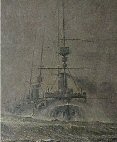seydlitz_slith
Posts: 2036
Joined: 6/16/2002
From: Danville, IL
Status: offline

|
Also during the turn, I-168 suffered a stuck main induction valve when she dived following her battery charge two hours before dawn a few miles south of Oahu.
Commander Nakamura ordered an emergency blow as soon as it was clear that there was a problem. The sub was still on the surface at that time but had already started her dive. With the main ballast and negative already flooding for the dive, the sub had a momentum that would not be stopped. The Commander called for the collision alarm and ordered all back emergency on the electric engines, batteries switched from parallel to series to maximize their power.
Most of the watertight doors had been closed when the flooding through the induction hit the engine room in a cascade so strong that no one could keep their feet. With a shower of sparks and electrical arcing the circuit breakers tripped and all power was lost. The sub, which had been trembling from the sudden reversal of the engines stopped her violent vibrations as the engines died. The reversing had just started to kill the way on the boat and she still had a good four knots of momentum carrying her deeper into the depths with the water rolling in.
"Planes to manual, set to forward planes to full rise and aft planes to 10 degrees down."
"Get a battle lantern on. Pump all compressed air that we have into the forward tank and blow the negative."
Throughout the ship, scattered flashlights and battle lanterns were switched on by the experienced crew.
"She's passing 60 meters, will she stop?"
The crew could feel the way coming off the ship as the air vented into the forward ballast and negative tanks. The sub continued to sink, but now it felt as if the ship was mushing down in the center. As they passed 80 meters the down angle became an up angle. At 90 meters the descent stopped and the sub began to take a nose up attitude. The flooding did not stop, and the extra weight of water in the engine room accentuated the bow angle by dragging the stern lower.
Finally, the sub began to rise. 80 meters, then 70, then 60, then faster and faster as the fully blown tanks pulled the sub towards the surface at an ever steeper angle. By 40 meters, the up angle was so steep that the crew couldn't keep their feet. At long last the bow broke the surface followed by the rest of the sub, the entire forward 20 meters of the vessel breaking free of the water before crashing back heavily into the water as the momentum was lost.
Eventually the sub came to rest, barely on the surface, most of the main deck under water and with a 10 degree starboard list. But at least the flow of water through the main induction had stopped. Her situation was grave. she was powerless, unable to dive, about to sink if she couldn't get pumps started, and only a few miles off the south coast of Oahu where search planes would surely find her during the morning light.
Luckily the crew was experienced and soon had some of the emergency pumps running by connecting directly to the forward batteries. A repair crew quickly fixed the stuck flapper on the main induction valve, and within four hours the water had been pumped out of the engine room by a combination of pumps and a bucket brigade. Even more fortunate was the weather. Just as dawn broke a thick squall line rolled in over the sub, and it continued to rain throughout the day, protecting her from the searching aircraft. By evening, the exhausted crew had made enough progress that they were able to restart one of the diesel engines, and the sub was able to pump enough air into her tanks to bring her into a seaworthy trim.
Due to the amount of damage done by the accident, the sub turned her nose west, sitting a course for Kwajalein. The crew considered themselves lucky to have survived the day and sincerely hoped that their crippled ship would be fortunate to survive the voyage to port in her damaged condition.

 Attachment (1) Attachment (1)
|
 Printable Version
Printable Version



































 New Messages
New Messages No New Messages
No New Messages Hot Topic w/ New Messages
Hot Topic w/ New Messages Hot Topic w/o New Messages
Hot Topic w/o New Messages Locked w/ New Messages
Locked w/ New Messages Locked w/o New Messages
Locked w/o New Messages Post New Thread
Post New Thread